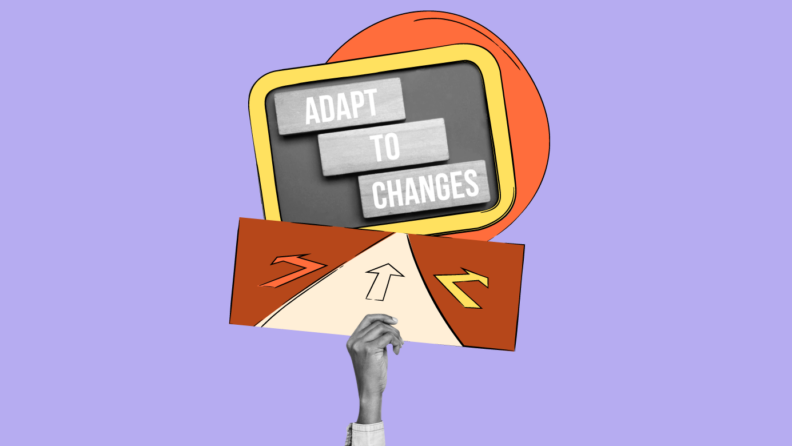Leading change and helping others adapt to it is a daunting task often riddled with misleading information, false assumptions and problem-solving methods that only try to change a few small things in the hope that will be enough.
Strong business leaders guide, coach and influence people to adapt, navigate change and build capabilities to accomplish the team’s most important goals. That’s adaptive leadership at the core.
In this article, I'll take a proactive approach toward helping leaders understand their role in change management across their organizations by leveraging the adaptive leadership model outlined by Harvard University Professor Ron Heifetz and the six key behaviors of adaptive leaders.
We’ll cover:
- What Is Adaptive Leadership
- Types Of Adaptive Leadership Challenges
- Principles Of Adaptive Leadership
- Qualities Of Adaptive Leaders
- Examples Of Adaptive Leadership
- Adaptive Leadership Criticisms
- How To Develop Your Adaptive Leadership Skills.
What is adaptive leadership?
Adaptive leadership theory, and the practice of adaptive leadership, focuses on the impact leaders have as they encourage people to adapt—to face and deal with problems, challenges and changes.
Adaptive Leadership Goals
The primary goals of adaptive leadership include:
- Navigating Complex Challenges - Helping leaders and teams navigate situations where there are no clear answers and traditional problem-solving methods may not be effective.
- Encouraging Learning and Growth - Encouraging individuals and teams to step out of their comfort zones, try new approaches, and learn from both successes and failures.
- Fostering a Resilient Work Culture - Embracing change and uncertainty helps in developing a culture that can adapt and thrive amidst challenges.
- Empowering and Mobilizing People - Encouraging collaborative problem-solving and leveraging the collective intelligence of the group.
- Facilitating Change and Innovation: Identifying and challenging the prevailing norms and values, and experimenting with new practices.
- Developing Adaptive Capabilities - Recognizing and addressing systemic issues and underlying dynamics that hinder progress.
- Enhancing Responsiveness to External Environments - Enabling the organization to anticipate trends and adjust strategies accordingly.
How Do Adaptive Leaders Help Others?
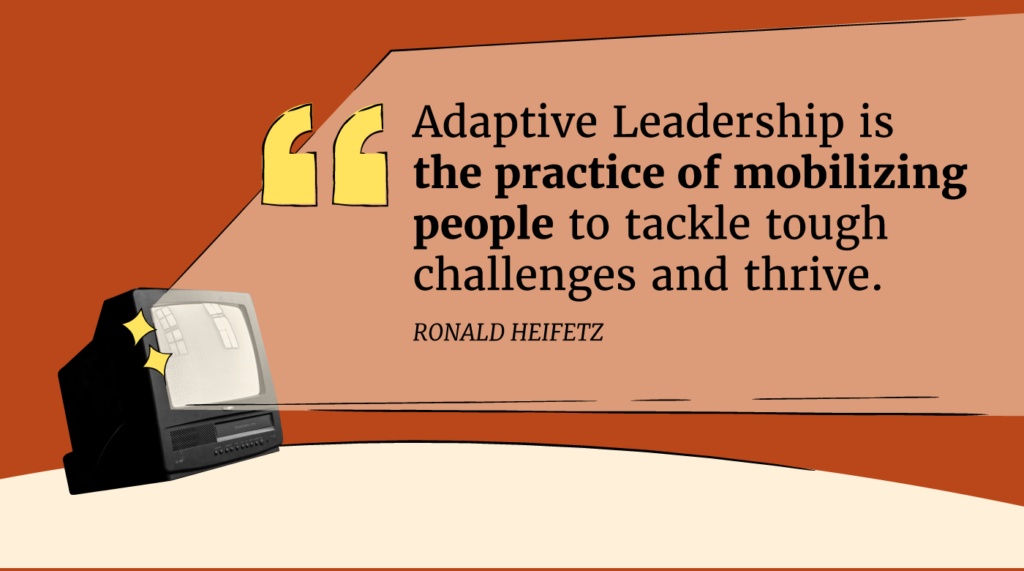
Adaptive leadership is not about adapting to different situations and solving problems for people.
Adaptive leadership is follower-centric, meaning, your job as an adaptive leader is to help others navigate change vs. figuring out how to be the change yourself.
Leaders who leverage adaptive leadership theory utilize a loose recipe of leadership behaviors and activities to guide followers through change.
Adaptive leaders help others achieve collective goals by:
- Mobilizing people and setting them in motion
- Motivating people and giving them the energy to accomplish the task
- Organizing people and providing structure for the work ahead
- Orienting people and sending them in the right direction
- Focusing people’s attention on what’s most important.
Adaptive leadership is not about the leader changing to meet the needs of the people. Instead, adaptive leadership is about leaders helping people [followers] to adapt to navigate the changing environment successfully.
Principles of Adaptive Leadership
The model of adaptive leadership focuses on leader behaviors and the adaptive work required to lead followers in navigating and solving situational challenges that are both technical and adaptive or purely adaptive in nature.
The adaptive leadership model highlights six key leadership behaviors that are used together in a non-linear fashion to support followers in navigating change and solving problems.
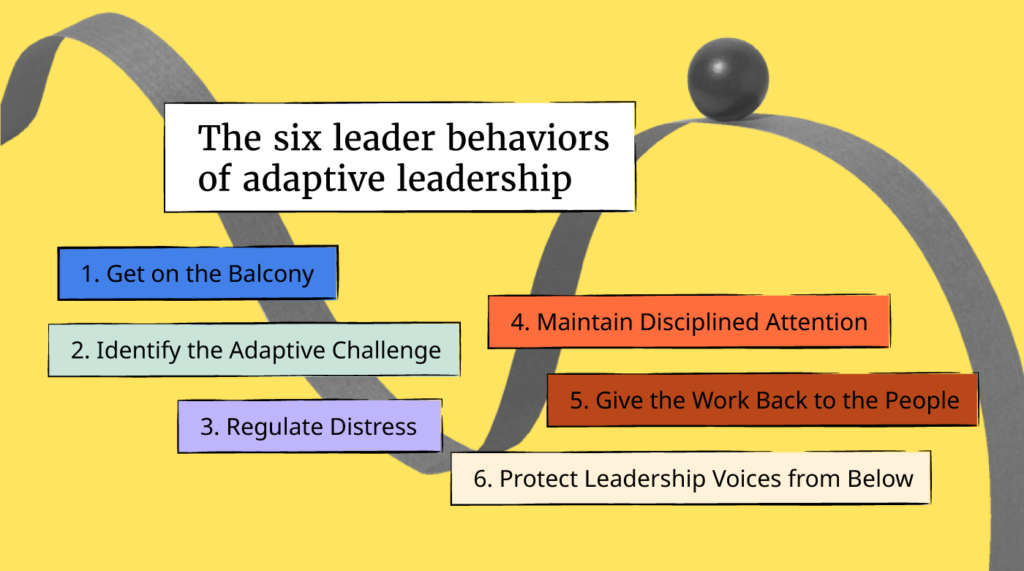
The six leader behaviors of adaptive leadership are:
- Get on the Balcony
- Identify the Adaptive Challenge
- Regulate Distress
- Maintain Disciplined Attention
- Give the Work Back to the People
- Protect Leadership Voices from Below
1. Get on the Balcony
Understand the big picture and gain a clear view of reality while leaving personal issues on the floor, seeing the forest through the trees.
2. Identify the Adaptive Challenge
Distinguish between technical and adaptive challenges
Four types of Adaptive Challenges:
- Gaps between espoused values and behavior
- Competing commitments e.g. quality vs. cost
- Elephants in the room
- People avoiding work.
3. Regulate Distress
Help others recognize the need for change without being overwhelmed by it. To do this, a leader must:
- Create a holding environment or a safe place to discuss everything and ask tough questions
- Provide direction, protection, orientation, conflict management and productive norms
- Regulate their own personal distress and the distress of workers, specifically, keeping it in the productive range or not going into a destructive space.
4. Maintain Disciplined Attention
Encourage people to focus on the tough work they need to do and keep at it!
5. Give the Work Back to the People
Avoid micro-managing and empower individuals to solve problems or create solutions in ways that are a good fit for the team.
6. Protect Leadership Voices from Below
Consider the ideas of everyone and pay special attention to people that are marginalized or even deviant in the group. All voices are important to consider when solving adaptive problems.
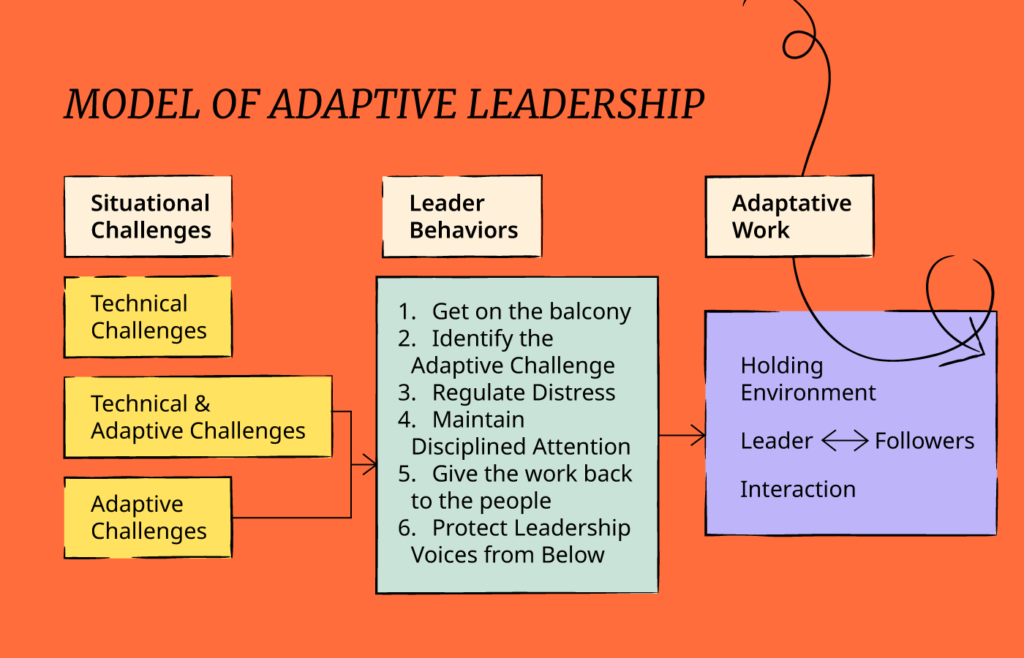
Leaders who effectively embody the adaptive leadership approach, and desired leader behaviors, create an environment where Adaptive Work can occur.
In this space, leaders and followers engage in the holding environment interactively, where they identify, test, and reflect on their efforts in solving problems.
When combined with the leader behaviors, the holding environment created by adaptive leaders allows people a safe space to experiment, fail fast, and learn about what might be a good solution to a current or future adaptive problem.
It is in the holding environment that people learn how to adapt to change themselves and build self-efficacy for tackling future adaptive challenges.
There is no prescribed order for following the leader behaviors, adaptive leadership incorporates many of the behaviors concurrently and interdependently with some being more important than others depending on the situation.
Overall, adaptive leadership works best when leaders engage in all of the identified leader behaviors with the intention of helping followers do adaptive work.
Types of Adaptive Leadership Challenges
Adaptive leadership theory characterizes all challenges leaders face as either adaptive, technical, or a combination of both, and offers a process-focused approach to helping followers navigate change associated with each type of challenge.
In the Adaptive Leadership model, problems or challenges workers face are either:
Technical Problems
Problems clearly defined with known solutions that can be implemented through existing organizational procedures.
Technical problems are often easy to identify and can be quickly solved by an authority or expert. Solving technical problems requires knowledge and the ability to execute.
Example: Your HRIS is currently not allowing new reports to be created. This has happened before and you were able to resolve the issue by calling the vendor and having them check your account.
Adaptive Problems
Problems that are not clearly defined and that do not have a clear solution. Adaptive problems require changes in values, beliefs, roles, relationships and approaches to be successful.
Solving adaptive problems requires innovation, experimentation and learning and, often, adaptive challenges impact people’s emotions. In fact, in adaptive challenges, people are often part of the problem!
Example: A midsize, family-owned software company merges with another small software company.
The merger creates confusion and chaos between employees of both organizations as the culture, hierarchy and processes between the two companies are vastly different.
The new leadership of the combined company must align and integrate the two groups of staff, and deliver value to the combined set of customers without losing too much revenue in the process of change.
Some problems are purely technical, but there are many problems that come bundled and are both technical and adaptive. Any technical problem that involves a change in human behavior, such as the use of a new system, is both a technical and adaptive problem.
Some problems are purely adaptive. These purely adaptive problems are often human behavior-centric and do not have a known or process-driven solution.
The single biggest failure in the exercise of leadership is to treat adaptive challenges like technical problems, and therefore to apply technical solutions. The need to differentiate between technical and adaptive challenges is crucial.
Ronald Heifetz
A tip for identifying what type of change you’re facing: a crisis is often an indicator of an adaptive problem. Technical fixes will not resolve an adaptive problem.
Adaptive leadership is especially concerned with helping people [followers] solve adaptive problems as it defines methods to address adaptive or adaptive/technical challenges.
Qualities of Adaptive Leaders
While not directly included in the behavior set for leaders by Heifetz, the following qualities are often associated with Travis Bradberry’s definition of adaptive leadership based upon research associated with his book, Leadership 2.0, where he sought to uncover what skills set adaptive leaders apart.
In my experience, these qualities are beneficial to have in a leader attempting to guide others through change.
- Emotional Intelligence (EI or EQ). A set of skills that help us understand our own emotions and the emotions of others so we can manage them effectively and build relationships.
- Organizational Justice. Fairness in decision-making, sharing information effectively, and being genuinely concerned about an outcome that’s right for impacted people.
- Character. A style of leadership that is transparent and forthcoming, admits mistakes, learns, and moves forward with a focus on authenticity and realness.
- Development. Continuous learning and innovation. Lifelong learning and application to real-world scenarios. Running the experiment, failing fast, and always seeking to improve.
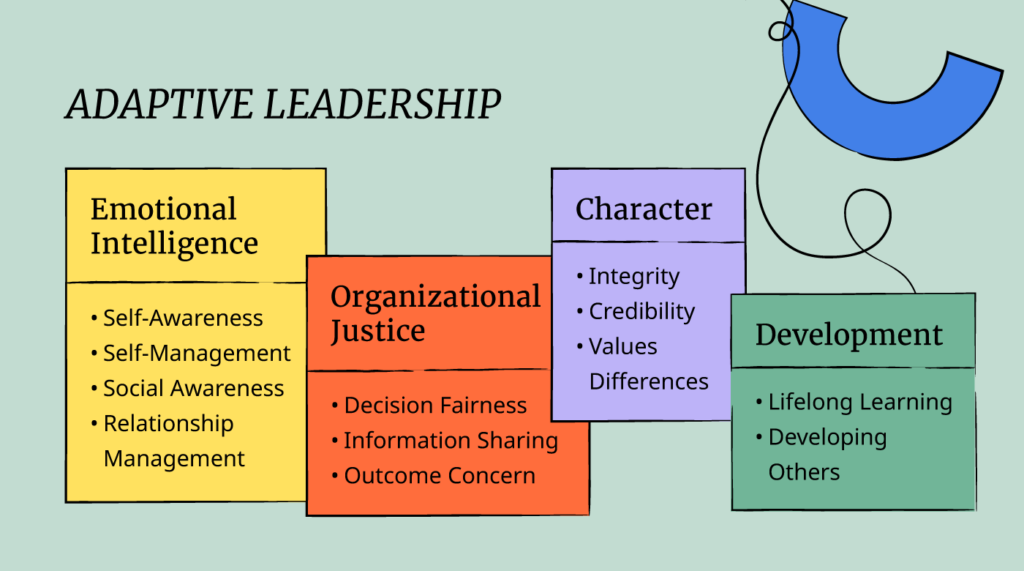
These adaptive leadership qualities, while not directly related to Heifetz’s adaptive leadership behaviors, do serve the model by describing some key elements of what makes an adaptive leader effective and well-prepared to help others navigate organizational change and thrive.
Examples of Adaptive Leadership in Practice
As mentioned in the intro, mergers and acquisitions (M&A) are significant change events impacting every aspect of the organization and the experience of being an employee in said organization.
When people experience the impacts or shock of being acquired or merging with another organization, they face many challenges, both technical and adaptive, throughout integration. Inevitably, they’ll look to leaders for support in navigating change to reach a new normal.
Example of Adaptive Challenges in M&A
In my work at Smarsh, I lead the initial stages of acquisition integration for acquired companies.
It was my job to partner with the leaders of the acquired organization to inform team members about the change in ownership and get them well on their way to becoming effective ‘Smarshians’.
Here are a few examples of technical, technical/adaptive and adaptive challenges we face in M&A integration from the perspective of the acquiring organization:
Technical Challenges
These are easy to understand and fixable by someone that knows how to:
- Get census report from acquired company’s HRIS
- Connect network infrastructure between companies
- Update the LinkedIn company page indicating the new company name.
Technical/Adaptive Challenges
These are harder to understand, but fixable by someone who knows how to experiment, exercise adaptive leadership behaviors and adapt their way to a successful solution. Some examples of technical/adaptive challenges are:
- Set up all acquired company employees in payroll and HRIS systems
- Onboard acquired company employees to new email systems
- Consolidate customer billing systems and processes.
Adaptive Challenges
These challenges are hard to understand, easy to deny, but fixable through practicing adaptive leadership behaviors and leading others in adapting their way to a successful solution. Some examples include:
- Define a new organizational hierarchy for the combined organizations
- Commit to combined sales team incentives for combined deals
- Navigate healthcare plan changes for acquired company employees.
For each category of challenges, there are proven techniques to help solve the various problems.
As a leader working to lead folks through these changes, I would constantly be looking at the six adaptive leader behaviors and checking in with each one over time, in a non-linear fashion, to be sure that I’m able to create space (holding environment) for adaptive work to occur within my teams.
Some of the behaviors will be more outwardly visible to others, but they are all important to creating an environment where people can experiment, innovate, fail fast and learn.
As you approach various types of challenges, consider adaptive leadership as a tool to provide insights and guidance for good practices in each step of the non-linear adaptive leadership framework, focusing on the behaviors and activities of the leader as they lead their followers through change.
Adaptive Leadership Criticisms
Adaptive leadership is quite strong in that it provides a non-linear process, variance in types of challenges to be addressed and specific behaviors to embody when leading others through change.
However, adaptive leadership is somewhat new in comparison to other leadership theories (such as transformational leadership), which means adaptive leadership has not had the same opportunity for rigorous empirical research.
A criticism of adaptive leadership is the fact that it does not include any of the following:
- A moral dimension - helping the organization do the right thing by society
- Socially useful outcomes - results that improve people's lives
- A relationship to diversity, equity, inclusion initiatives - DEI results rely on leadership buy in. They are not a given as the result of an adaptive leadership style.
- A tie to organizational justice - if leaders don't already possess fairness in decision making and interpersonal interactions, adaptive leadership won't yield those things for you.
More research is required in these areas to expand empirical evidence for adaptive leadership while improving the theory’s connections to social justice issues, especially in the context of adaptive or technical/adaptive challenges.
How to Develop Your Adaptive Leadership Skills
- Learn from others
- Be open to change
- Refer to adaptive leadership model often
- Stay current with trends
- Self-reflection
An adaptive leader is constantly learning and growing. They are open to new ideas and ways of doing things.
Here are some tips for developing your skills as an adaptive leader:
1. Learn from others
There’s a lot of wisdom to be found in the experiences of others. Seek out mentors and other leaders who can help you grow and develop your skills toward becoming an adaptive leader.
Apply the adaptive leadership model in your review of case studies and consider if the challenges faced are technical, technical/adaptive, or purely adaptive in nature.
Learn to identify what type of problem you and the team are facing, and consider what additional adaptive forces may be at play, especially when considering a technical problem.
2. Be open to change and invest in your follower relationships
Leaders who are adaptable are not afraid of change, and they know that flexibility is essential in order to be successful. Learn to lead others in being open to change as well.
Creating adaptive space for experimentation and being open to change will create a culture of innovation and trust. Trust is key.
3. Keep the adaptive leadership model handy and refer to it often
One of the best ways to make a practice permanent is to keep it visible and refer to it often.
Teach your colleagues about adaptive leadership and ask them to consider how to create space for adaptive work in your organization.
When you hit a roadblock, consult the adaptive leader behavior list and consider if there’s an opportunity to exercise any of the behaviors to create space for followers to adapt towards a positive outcome.
Practice these three steps to gain clarity and determine how to move forward in the context of adaptive work:
- Observe
- Interpret
- Intervene
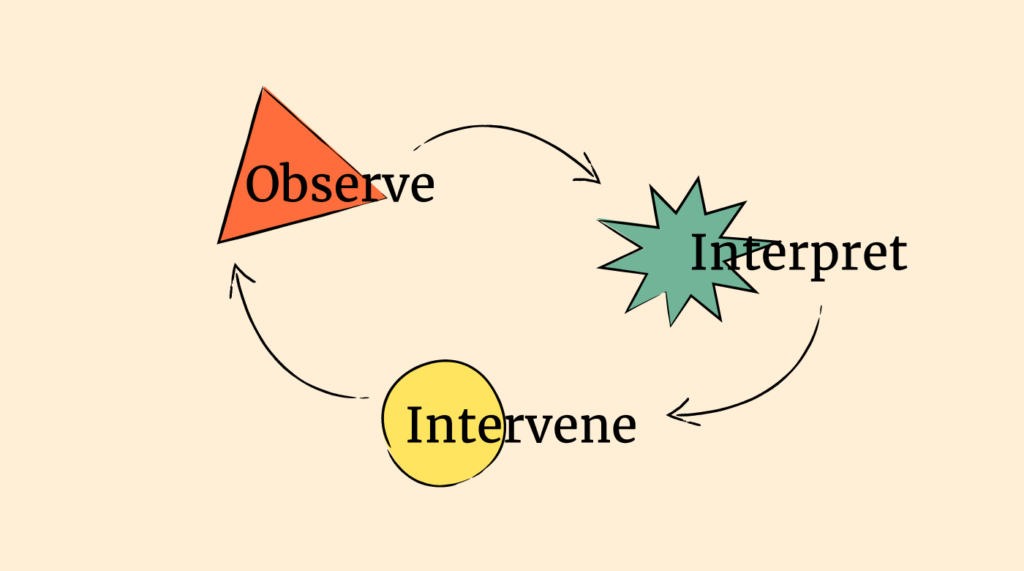
Repeat this exercise to continue experimenting and learning how to lead effectively through change.
Over time, your understanding of the scenarios at hand and your navigation skills will improve.
Of special note, be sure to “get on the balcony” early and often. In my experience, it's rarely about what it's about—so get up there and see what’s actually going on!
4. Stay current with trends and changes in your industry
Adaptive leaders need to be aware of the latest developments in their field so that they can stay informed such that they can identify a technical or adaptive change.
Read industry journals, attend conferences, and network with other professionals in order to stay informed and consider what current or upcoming changes in your environment might influence a technical change to become adaptive or vice versa.
Has something changed such that you can make the right thing the easy thing? Amazing.
5. Practice self-reflection
A big part of being an adaptive leader is being able to reflect on what has happened in your organization and how your behavior as a leader has influenced the behaviors or attitudes of followers (both positively and negatively).
Take time for self-reflection and ask others for feedback so that you can continue to grow and develop as a leader who seeks to create space for followers to do their best adaptive work.
Get ready to help others navigate change!
Are you ready to support people in navigating change?
Get started with the behaviors above and start talking with your colleagues about the difference between technical, technical/adaptive, and adaptive problems!
3 Key takeaways
- Emphasis on Navigating Change: Adaptive leadership is primarily about guiding others through change, not just adapting oneself to different situations. It involves mobilizing, motivating and organizing people to collectively address challenges, especially those that are complex and require shifts in values, beliefs or behavior.
- Follower-Centric Approach: This leadership style is centered around empowering followers to tackle challenges. It utilizes specific behaviors and activities, like creating a safe space for discussion (the holding environment), encouraging focus on critical issues and allowing for experimentation and learning to facilitate problem-solving and adaptation among team members.
- Differentiation of Challenges: Adaptive leadership distinguishes between technical problems, which have clear solutions and adaptive challenges, which are more complex and require innovative and experimental approaches. It emphasizes the importance of understanding the nature of challenges to apply the appropriate strategies and behaviors for effective resolution.
If you’ve found this helpful, subscribe to the People Managing People newsletter to stay up to date on the latest people-centric trends and opportunities to become a stronger leader.


